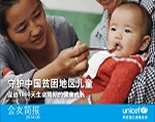Beijing, May 30, 2012 — Each year tens of thousands of children in China die due to drowning, road accidents, or other injuries such as suffocation, poisoning or falls. According to United Nations Children's Fund (UNICEF) data, injuries are the leading cause of death for children five to fourteen years of age, and the third leading cause of death for children below the age of five.
 ©UNICEF/China/2012/Sun Peng ©UNICEF/China/2012/Sun Peng
An audience of over 100 people gathered at the "Prevent Child Injury, Keep Children Safe" advocacy event which was held at the Beijing Women and Children Service Centre in Beijing. |
Child injury is now considered the most significant health problem for children. It is estimated that for every single death of a child due to injury another three are permanently disabled and an additional eighteen children require surgery or long term hospitalization.
"This Children's Day we are joining with key partners to raise awareness both to the significance of this emerging major threat to children, as well as the role of education and information in preventing child injury," said Ms. Gillian Mellsop, UNICEF China Representative. "Above all else this is an awareness-raising challenge. And we need to use every possible channel of communication available to make parents and caregivers more aware of this problem."
Ms Mellsop was speaking at the "Prevent Child Injuries, Keep Children Safe: Child Injury Prevention Advocacy and Intervention Strategy Seminar" at the Beijing Women and Children Social Service Centre.
 ©UNICEF/China/2012/Sun Peng ©UNICEF/China/2012/Sun Peng
Maggie Cheung, UNICEF Ambassador for China, sharing thoughts on the issue of child injury prevention following the premier of a short film produced about her recent field visit to the UNICEF child injury prevention project in Jiangxi Province. |
UNICEF yesterday joined with the National Working Committee on Children and Women (NWCCW), the Ministry of Health and the Chinese Centre for Disease Control and Prevention (CDC) to organize the event.
The UNICEF China Office is scaling up its efforts to promote public engagement in actions to protect children from child injuries through various social media activities.
"Injury is not only life-threatening, but it also creates a heavy economic and psychological burden for families and society as a whole," said Ms. Song Wenzhen, Deputy Director General of NWCCW. "We found that child injury can be prevented if we increase safety awareness of the public and take prevention measures…Injury prevention is one of the most cost effective of all child welfare initiatives."
Also on hand at the event was cinema artist Maggie Cheung, in her capacity as UNICEF Ambassador for China, to premier a short film made by UNICEF featuring her recent trip to one of UNICEF's child injury prevention project sites in Jiangxi Province.
In remarks following the video showing Maggie Cheung made this call: "China is developing very fast and many children, like the families I visited, whose parents work in cities, suffer a lot from injuries. Many of these rural families are just not aware of the risks to their children."
According to a 2007 survey commissioned by UNICEF, children left behind by migrant worker parents are two or more times likely to die from an injury than children living with their parents.
As infectious diseases have dramatically declined in China in the last 20 years, injury and accidents are becoming much more significant health problems for children.
"With years of effort, we have established a national network to monitor and prevent injuries," said Mr. Liang Xiaofeng, Deputy Director General, Chinese Centre for Disease Control and Prevention (CDC). "Child injury and prevention are increasingly integrated into the daily routine of CDC."
Globally child injury is a significant public health problem. Around 381,000 children under five die every year due to injury and violence. In addition to the deaths, tens of millions of children seek hospital care for unintentional injuries. Many of them are left with lifelong disabilities[1].
A newly released UNICEF report examining child drowning in five Asian countries finds that one in four deaths of children above the age of one are due to drowning. The report examines data from Bangladesh, Cambodia, China (Jiangxi Province and Beijing), Thailand and Vietnam.
"Most of these deaths are easily preventable," said Gillian Mellsop. "The majority of drowning related child deaths occur just 20 meters from home in sunny weather."
UNICEF has been supporting NWCCW and MOH to implement its child injury prevention programme since 2003, with pilot project sites in Jiangxi Province and Beijing. After the first four years of partnership in Jiangxi the rate of non-fatal injuries in project sites had declined by 50 per cent.
The project partnership's main slogan is "Safe Home, Safe School, Safe Community" and its primary focus has been on community awareness raising and local government capacity building.
About UNICEF in China:
UNICEF first assisted China between 1947 and 1951, providing emergency services, food and nutrition, health and hygiene training during and after the Civil War. In 1979 UNICEF officially commenced its cooperation with the Government of China to support child health and nutrition, good water and sanitation, quality basic education for all boys and girls, and the protection of children from violence, exploitation, and AIDS. UNICEF is on the ground in over 190 countries and territories to help children survive and thrive, from early childhood through adolescence.
Visit our official website: www.unicef.cn
Follow us: Sina Weibo http://weibo.com/unicefchina Tecent Weibo http://t.qq.com/unicef
For further information, please contact: Dale Rutstein, UNICEF China, +8610 65323131 ext. 1301, drutstein@unicef.org or Liu Li, UNICEF China, +8610 65323131 ext. 1303, liliu@unicef.org
[1]WHO, Profile of Child Injuries: Selected Member States in the Asia - Pacific Region, 2010






























